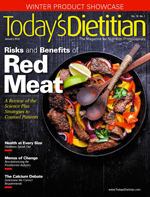 January 2016 Issue
January 2016 Issue
Editor's Spot: Stop the Presses!
By Judy Riddle
Todays' Dietitian
Vol. 18 No. 1 P. 4
On January 7, the 2015–2020 Dietary Guidelines for Americans (DGA) were released, and the dietetics community is buzzing with excitement. The latest guidelines expand on the 2010 edition by focusing on overall eating patterns to achieve optimal health across the lifespan vs individual foods, food groups, and nutrients, and by setting new, key recommendations for cholesterol, added sugars, and saturated fat intake.
According to the US Department of Health and Human Services website, healthy eating patterns include a variety of nutritious foods such as fruits and vegetables, grains, low-fat and fat-free dairy, lean meats and other protein foods, and oils, while limiting saturated fats, trans fats, added sugars, and sodium.
In my opinion, what's most notable about the 2015–2020 DGA are the changes to the cholesterol and sodium recommendations. The 300 mg daily limit on dietary cholesterol was removed, and eggs are included in the three recommended healthful eating patterns, such as the Mediterranean-style, vegetarian-style, and healthy US-style of eating, shown to lower risk of chronic diseases (eg, type 2 diabetes, cardiovascular disease, and some cancers). People older than 14 are recommended to consume less than 2,300 mg per day of sodium, and those who are younger should consume less. (The 2010 edition recommended that Americans aged 2 and older lower sodium intake to less than 2,300 mg per day and 1,500 mg per day for those aged 51 and older and those of any age who are African American or have hypertension, diabetes, or chronic kidney disease.)
The new guidelines also recommend individuals consume less than 10% of calories per day from added sugars and consume less than 10% of calories per day from saturated fats.
To read the 2015–2020 Dietary Guidelines for Americans in its entirety, visit health.gov/dietaryguidelines/2015/guidelines. Look for additional coverage on the guidelines on our website and in a future issue of Today's Dietitian (TD) in which we'll provide feedback from your colleagues and strategies for counseling clients and patients on how to implement the new recommendations into their daily lives.
This month's issue features articles on the risks and benefits of red meat, the Goldring Center for Culinary Medicine at the Tulane School of Medicine Teaching Kitchen, the Health at Every Size movement, and the Menus of Change initiative that's changing the face of the foodservice industry. The staff of TD wishes you a prosperous, happy New Year. Please enjoy the issue!
Judith Riddle
Editor
TDeditor@gvpub.com
